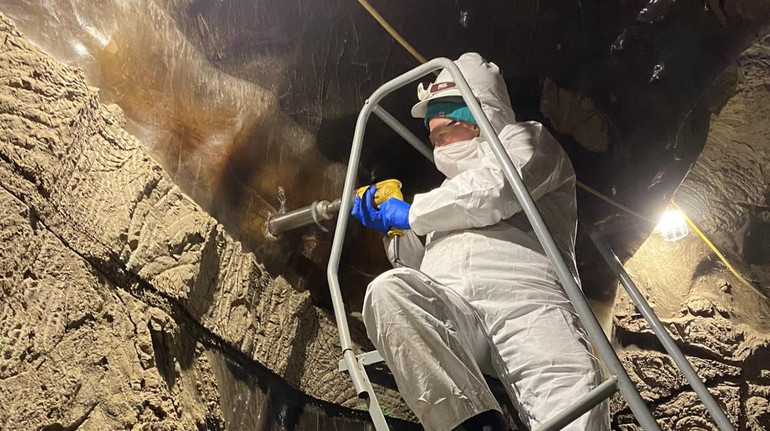“
 Statue of Napoleon Bonaparte in Laffre, France
Statue of Napoleon Bonaparte in Laffre, France
Photo: Elenarts/DepositPhotos
However, a recent analysis of the soldiers’ remains cast doubt on this thesis. Scientists found out that at least two other pathogens played a decisive role in the death of thousands of people.
This is stated in a study published in Current Biology, they write The Guardian and Popular Science.
The idea that typhus was the main cause of death in Napoleon’s army has remained popular for decades. Initial reports from French doctors and soldiers mention that the disease probably killed more troops than the Russians.
This version was also confirmed by the fact that the main carrier of typhus – clothes lice – was found on the remains, and traces of the bacterial causative agent of typhus were found in the DNA.
However, technological progress opened a new way to study the losses of Napoleon’s army. To learn more about the defeat of the French emperor, scientists studied the remains of soldiers from a mass burial in Vilnius (Lithuania).
Scientists removed teeth from 13 bodies of the dead and sequenced (determined gene sequences) DNA from them. The samples were also cleaned of external contamination to look for evidence of bacterial pathogens.
However, no traces of typhus were found in any of the dead – only fragments of Salmonella enterica and Borrelia recurrentis bacteria. The first microbe is capable of causing typhoid, and the second – relapsing typhus.
The first disease got its name because of symptoms that resemble typhus. The second disease was not recognized as a separate disease until the end of the 19th century – like typhus, it is often transmitted by clothes lice.

The authors of the work refuted previous studies that found signs of typhus and trench fever in the same burial. According to scientists, the reason for the earlier mistakes was the use of different sequencing technologies.
“Ancient DNA is severely degraded into pieces that are too small to work with the polymerase chain reaction (the method used for the previous study – ed.).
Our method is able to cover a wider network and a wider range of DNA sources based on these very short ancient sequences.”– said the leader of the work, Nicolas Rasquan from the Pasteur Institute (France).
Scientists assume that a combination of fatigue, cold and the spread of several diseases caused the deaths of the soldiersincluding paratyphoid and relapsing typhus.
Earlier scientists found outthat the eruption of the Vesuvius volcano was not the only cause of the death of the ancient Roman city of Pompeii.

”, — write: www.pravda.com.ua
 Statue of Napoleon Bonaparte in Laffre, France
Statue of Napoleon Bonaparte in Laffre, France
Photo: Elenarts/DepositPhotos
However, a recent analysis of the soldiers’ remains cast doubt on this thesis. Scientists found out that at least two other pathogens played a decisive role in the death of thousands of people.
This is stated in a study published in Current Biology, they write The Guardian and Popular Science.
The idea that typhus was the main cause of death in Napoleon’s army has remained popular for decades. Initial reports from French doctors and soldiers mention that the disease probably killed more troops than the Russians.
This version was also confirmed by the fact that the main carrier of typhus – clothes lice – was found on the remains, and traces of the bacterial causative agent of typhus were found in the DNA.
However, technological progress opened a new way to study the losses of Napoleon’s army. To learn more about the defeat of the French emperor, scientists studied the remains of soldiers from a mass burial in Vilnius (Lithuania).
Scientists removed teeth from 13 bodies of the dead and sequenced (determined gene sequences) DNA from them. The samples were also cleaned of external contamination to look for evidence of bacterial pathogens.
However, no traces of typhus were found in any of the dead – only fragments of Salmonella enterica and Borrelia recurrentis bacteria. The first microbe is capable of causing typhoid, and the second – relapsing typhus.
The first disease got its name because of symptoms that resemble typhus. The second disease was not recognized as a separate disease until the end of the 19th century – like typhus, it is often transmitted by clothes lice.

The authors of the work refuted previous studies that found signs of typhus and trench fever in the same burial. According to scientists, the reason for the earlier mistakes was the use of different sequencing technologies.
“Ancient DNA is severely degraded into pieces that are too small to work with the polymerase chain reaction (the method used for the previous study – ed.).
Our method is able to cover a wider network and a wider range of DNA sources based on these very short ancient sequences.”– said the leader of the work, Nicolas Rasquan from the Pasteur Institute (France).
Scientists assume that a combination of fatigue, cold and the spread of several diseases caused the deaths of the soldiersincluding paratyphoid and relapsing typhus.
Earlier scientists found outthat the eruption of the Vesuvius volcano was not the only cause of the death of the ancient Roman city of Pompeii.

